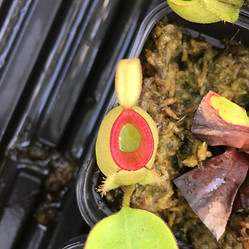How does a carnivorous plant trap its prey?

Hi everybody! Welcome to our second lesson in CP Heaven's learning lab!
Today we will be learning about 5 different types of traps carnivorous plants use to catch their prey.
They are:
-
Snap
-
Flypaper
-
Suction
-
Pitfall
-
Lobster pot
Snap Traps
Snap traps are active trap that snaps quickly at prey that wanders into it.
Little hairs inside this trap are sensory hairs which the plant can detect movement if there's anything inside. If any of the hairs inside had been touched twice within 30 seconds, the trap will snap shut.
The most famous carnivorous plant in the world is the Venus flytrap. Its trap not only catches insects and small animals but also many of our hearts. 😄


Flypaper Traps
These traps are passive traps that await patiently for food to get onto them. The trap sticks to the prey, usually small flying insects.


Suction Traps
The trap of bladderwort uses extremely microscopic active traps to suck its prey into its little pouch when the tiny hairs were touched by microscopic animals like zooplankton.

Pitfall Traps
The traps of pitcher plants use pitfall traps to catch their prey and sometimes even animal excretion. It's a passive trap that makes use of gravity to drown the victim in a pool of liquid that the pouch is holding. It's like a stomach that can secrete acid to break down its food and to be absorbed by the plant. To me, this type of trap is the most elegant trap. It does everything by doing nothing, and unlike traps like the venus flytrap, it is catch as much prey as it can hold without "closing shop" after catching a meal.


Lobster pot Traps
What is a lobster pot trap? It's a passive trap used by Sarracenia psittacina to trap its prey.
The prey, usually a tadpole, swims into the opening of the trap. The tadpole starts to taste the bait, then it moves into the part where all the hairs are pointing inwards. These hairs obstruct the tadpole from getting out and it eventually dies and is digested by the plant.






